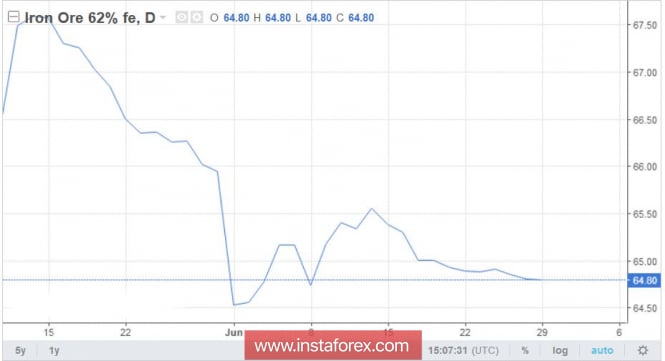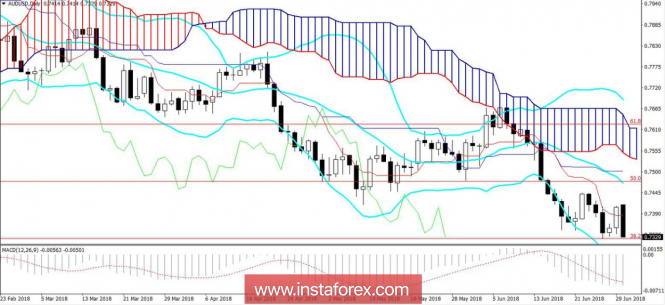On Friday, the Australian dollar paired with the US currency unexpectedly and fairly rapidly strengthened, reaching the 74th figure. However today, the Aussie has already fallen to the bottom of the annual minima, leveling the success of last week. Such wavelike price fluctuations reflect the general nervousness of the market, which is caused by the trade war between the US and China.
Despite the background pressure of the US-China conflict, Friday's weakening of the US dollar was quite unexpected. By and large, traders had no reason for such impulse movement. Of course, the greenback now takes a somewhat controversial position. On one hand, the currency is under pressure from Trump's foreign trade policy, but on the other hand, it continues to be in demand, although not as active as in the spring.
Interest in reliable assets, among which "the dollar" is listed, is also fueled by political conflicts in the European Union, where the migration crisis again flares up. There are reasonable risks that this crisis will provoke the collapse of the government coalition in Germany, and Europe will again find itself in a swamp of political uncertainty. And if traders survived the political crises in Italy and Spain which is relatively easy, then German events can turn into very sad consequences for the market (from the re-elections to the Bundestag, ending with the prospects of the "hawkish" Jens Weidmann to head the ECB in 2019).
In other words, the boat of political stability is again rocking in Europe, so the demand for US currency does not decrease. Pay attention to the dynamics of the dollar index and compare with the level of profitability of 10-year US government bonds. The corroboration of these indicators suggests that the greenback grows without looking back at Treasury. Although quite recently, the opposite picture was observed: the growth of the yield of treasury securities "pulled" the dollar for itself, while many of the underlying fundamental factors were ignored by the market.
So what was the result of Friday's "failure" of the dollar? According to most experts, there were no prerequisites for this. Market participants only recorded profits on the last trading day of June against the background of ambiguous prospects for the US-China trade war. Today, the situation has largely returned to normal. The risk of political crisis returned interest to the dollar, while Beijing and Washington are in a "fighting stance", preparing the ground for further steps. So, in just four days (July 6), the first import duties of the White House against China will come into effect. On the eve of this event, the financial world is arguing about the possible consequences of this step, or rather, the effect from the likely "domino effect".
For example, the dynamics of the Chinese yuan speaks eloquently that Beijing uses the exchange value of its currency as a defensive weapon in a trade war and defends exporters with the help of devaluation. However, such steps are fraught with "side effects" (problems with liquidity in the domestic market, instability of the credit market, outflow of capital), which can turn into big problems for the Chinese economy in particular and for the world economy as a whole. Trump, in turn, has not yet used the whole arsenal of voiced ideas, at least in the matter of restricting Chinese investments.
If we talk directly about the Australian currency, then the raw material market is an additional factor of pressure. Steel, iron ore, and coking coal continue to lose value. It has become actively cheaper while copper reached almost the annual minimum (today, a ton of raw materials are traded at $ 6476, whereas at the beginning of the year the price was at $ 7090).

All of the above suggests that the Reserve Bank of Australia, at its July meeting (which will be held on July 3 during the Asian session), will not tighten its rhetoric, preserving the parameters of the monetary policy. External risks such as weak inflation and wage growth, a fall in the commodity market, and "cool" political relations with Beijing, all these factors reduce the likelihood of strong intentions on the part of the RBA. According to most experts, the Central Bank will return to the issue of raising rates not earlier than the second half of 2019, despite the growth of Australia's GDP in the first quarter of this year. Thus, the "soft" position of the RBA may increase pressure on the Australian dollar in the medium term.
From a technical point of view, the pair demonstrates a pronounced bearish trend, which is confirmed by the main trend indicators: Bollinger Bands and Ichimoku Kinko Hyo. So, the indicator Ichimoku Kinko Hyo on the weekly chart formed the strongest bearish signal "Parade of lines", in which all lines of the indicator are above the price chart, thereby demonstrating the pressure on the pair. In turn, the price is on the bottom line of the indicator Bollinger Bands, which shows a narrowed channel, this is also a strong signal for the southern direction.

Additional confirmation of the bearish scenario is the oversoldness of the MACD and Stochastic oscillators. The nearest resistance level is the Tenkan-sen line of the Ichimoku Kinko Hyo indicator, which corresponds to the 0.7500 mark. However, in the near future, this level is unlikely to be achieved with a high probability of the AUD/USD pair updating to the annual minimum price.
The material has been provided by InstaForex Company - www.instaforex.com